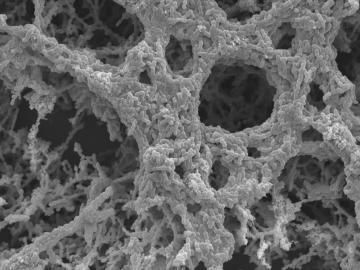Mechanism discovered which aids Legionella to camouflage itself in the organism
The feared Legionella pneumophila bacteria is responsible for legionellosis, an infectious disease that can lead to pneumonia. In order to infect us, this pathogen has developed a complex method enabling it to camouflage itself and go unnoticed in our cells, thus avoiding these acting against the infectious bacteria.
Research led by the Basque biosciences research centre, CIC bioGUNE, in which teams from the National Institute of Health (NIH) of the USA and the National Supercomputation Centre in Barcelona (BSC) have also participated, has described for the first time a mechanism that aids this bacteria to camouflage itself in human cells. The research, recently published in the prestigious PLOS Pathogens, resolved the structure of the SidD protein of the Legionella pneumophila, involved in the interference of cell processes during infection.
Legionella, which lives in stagnant water, gains access to our organism through the respiratory tract, when we inhale contaminated microscopic drops of water. Once there, the cells of the immune system phagocytise it (that is, they 'swallow' it up), but are not able to destroy it. This is due to the fact that the bacteria manages to manipulate the host cell to go unnoticed inside it and multiply itself without being destroyed.
The strategy of the bacteria involves releasing about 300 proteins into the cell, which in turn act on the host proteins in order to avoid being recognized as an infectious agent and thus go unnoticed during the time necessary to multiply itself.
One of these proteins, concretely the Legionella SidD protein, regulates a chemical modification involved in the process of intracellular camouflage. It is precisely the function of this protein which the research by CIC bioGUNE, the NIH and the BSC has described. Once the Legionell has managed to multiply itself, the SidD protein unblocks cellular processes which favour the advance of the infection.
New targets
"Legionella pneumophila is an organism which, during millions of years of evolution, has learnt to manipulate our proteins to its own benefit in order to thus favour the infection", explained CIC bioGUNE researcher, Aitor Hierro. "Knowing how it does this", he added, "can help us to manipulate our proteins to our own benefit".
The discovery of the mechanism enabling the bacteria to survive and develop within our cells could give rise to the discovery of new findings. According to Mr. Hierro, "this knowledge not only reveals new targets that can be used for designing inhibitors, but also shows us molecular mechanisms that can be readapted and used, for example, in the selective transport of molecules for therapeutic use".
Organizations
Other news from the department science

Get the life science industry in your inbox
By submitting this form you agree that LUMITOS AG will send you the newsletter(s) selected above by email. Your data will not be passed on to third parties. Your data will be stored and processed in accordance with our data protection regulations. LUMITOS may contact you by email for the purpose of advertising or market and opinion surveys. You can revoke your consent at any time without giving reasons to LUMITOS AG, Ernst-Augustin-Str. 2, 12489 Berlin, Germany or by e-mail at revoke@lumitos.com with effect for the future. In addition, each email contains a link to unsubscribe from the corresponding newsletter.



















































